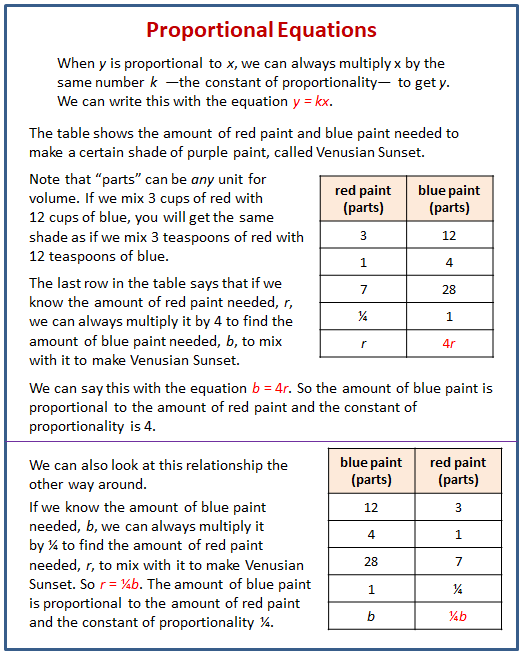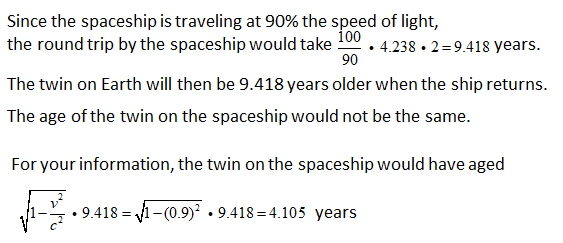Illustrative Mathematics Grade 7, Unit 2, Lesson 4: Proportional Relationships and Equations
Learning Targets:
- I can write an equation of the form y = kx to represent a proportional relationship described by a table or a story.
- I can write the constant of proportionality as an entry in a table.
Related Pages
Illustrative Math
Grade 7
Lesson 4: Proportional Relationships and Equations
Let’s write equations describing proportional relationships.
Illustrative Math Unit 7.2, Lesson 4 (printable worksheets)
Lesson 4 Summary
The following diagram shows how to write an equation of the form y = kx to represent a proportional relationship described by a table or a story.

Lesson 4.1 Number Talk: Division
Find each quotient mentally.
645 ÷ 100
645 ÷ 50
48.6 ÷ 30
48.6 ÷ x
Lesson 4.2 Feeding a Crowd, Revisited
- A recipe says that 2 cups of dry rice will serve 6 people. Complete the table as you answer the questions. Be prepared to explain your reasoning.
a. How many people will 1 cup of rice serve?
b. How many people will 3 cups of rice serve? 12 cups? 43 cups?
c. How many people will x cups of rice serve? - A recipe says that 6 spring rolls will serve 3 people. Complete the table as you answer the questions. Be prepared to explain your reasoning.
a. How many people will 1 spring roll serve?
b. How many people will 10 spring rolls serve? 16 spring rolls? 25 spring rolls?
c. How many people will n spring rolls serve? - How was completing this table different from the previous table? How was it the same?
Lesson 4.3 Denver to Chicago
A plane flew at a constant speed between Denver and Chicago. It took the plane 1.5 hours to fly 915 miles.
- Complete the table.
- How far does the plane fly in one hour?
- How far would the plane fly in t hours at this speed?
- If d represents the distance that the plane flies at this speed for t hours, write an equation that relates t and d.
- How far would the plane fly in 3 hours at this speed? in 3.5 hours? Explain or show your reasoning.
Are you ready for more?
A rocky planet orbits Proxima Centauri, a star that is about 1.3 parsecs from Earth. This planet is the closest planet outside of our solar system.
- How long does it take light from Proxima Centauri to reach the Earth? (A parsec is about 3.26 light years. A light year is the distance light travels in one year.)
-
Show Answer
1.3 · 3.26 = 4.238 years
-
Show Answer
- There are two twins. One twin wants to explore the planet near Proxima Centauri and leaves on a spaceship traveling at 90% of the speed of light, while the other twin stays home on Earth. How much does the twin on Earth age while the other twin travels to Proxima Centauri? (Do you think the answer would be the same for the other twin? Consider researching “The Twin Paradox” to learn more.)
Lesson 4.4 Revisiting Bread Dough
A bakery uses 8 tablespoons of honey for every 10 cups of flour to make bread dough. Some days they bake bigger batches and some days they bake smaller batches, but they always use the same ratio of honey to flour.
- Complete the table.
- If f is the cups of flour needed for h tablespoons of honey, write an equation that relates f and h.
- How much flour is needed for 15 tablespoons of honey? 17 tablespoons? Explain or show your reasoning.
Lesson 4 Practice Problems
- A certain ceiling is made up of tiles. Every square meter of ceiling requires 10.75 tiles. Fill in the table with the missing values.
- On a flight from New York to London, an airplane travels at a constant speed. An equation relating the distance traveled in miles, d, to the number of hours flying, t, is t = 1/500 d. How long will it take the airplane to travel 800 miles?
- Each table represents a proportional relationship. For each, find the constant of proportionality, and write an equation that represents the relationship.
- A map of Colorado says that the scale is 1 inch to 20 miles or 1 to 1,267,200. Are these two ways of reporting the scale the same? Explain your reasoning.
- Here is a polygon on a grid.
a. Draw a scaled copy of the polygon using a scale factor of 3. Label the copy A.
b. Draw a scaled copy of the polygon with a scale factor 1/2. Label it B.
c. Is Polygon A a scaled copy of Polygon B? If so, what is the scale factor that takes B to A?
The Open Up Resources math curriculum is free to download from the Open Up Resources website and is also available from Illustrative Mathematics.
Try out our new and fun Fraction Concoction Game.
Add and subtract fractions to make exciting fraction concoctions following a recipe. There are four levels of difficulty: Easy, medium, hard and insane. Practice the basics of fraction addition and subtraction or challenge yourself with the insane level.

We welcome your feedback, comments and questions about this site or page. Please submit your feedback or enquiries via our Feedback page.
